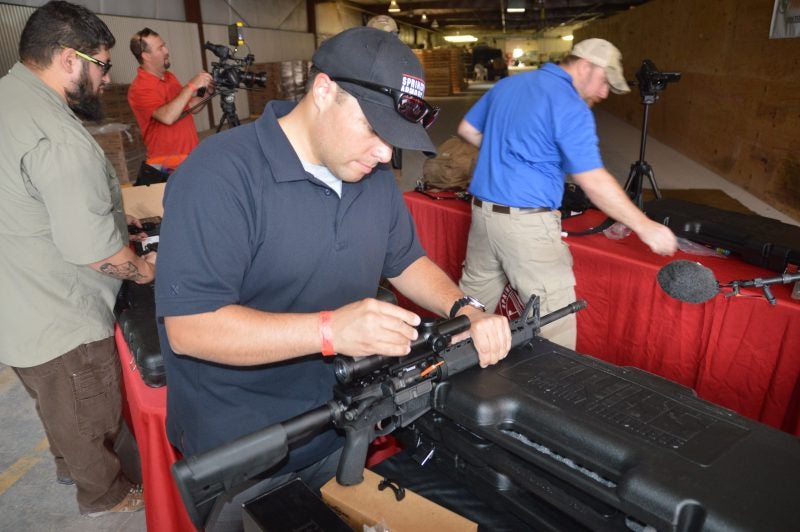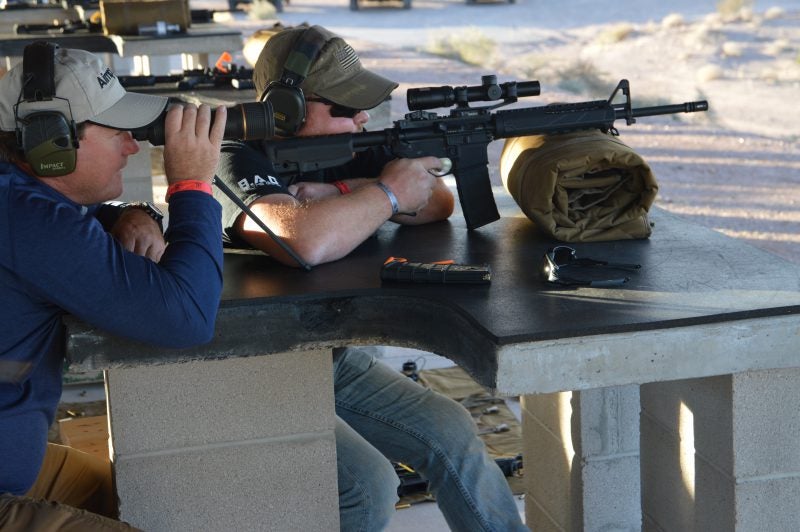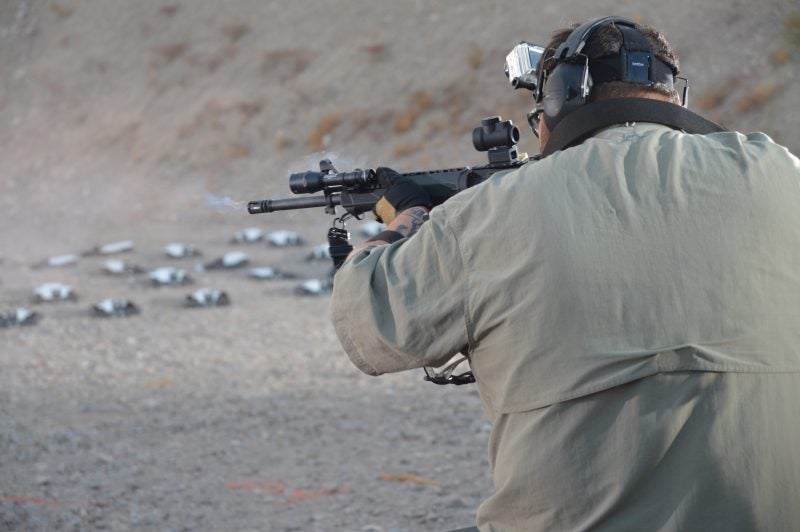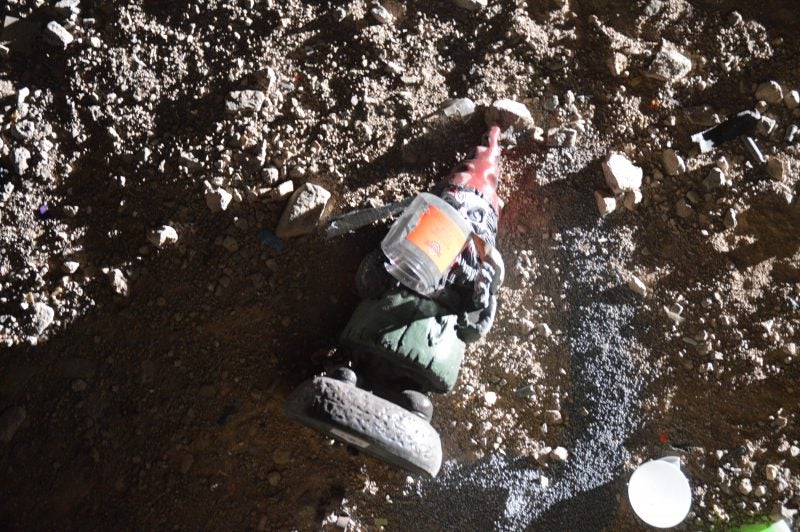Shooting the Springfield Armory SAINT
Rob Reed 11.01.16

I was one of the gun writers invited to get some hands-on time with Springfield Armory’s new SAINT at their recent media event in Las Vegas. In my last post I covered the tech specs of the gun from the spec sheet provided by Springfield Armory. In this post I’m going to be more subjective, give my own opinions on the gun, and speculate a bit on some of the thinking behind certain decisions.
First, to recap, the SAINT is a standard direct-impingement flattop carbine with a 16″ 1:8 twist 5.56 barrel, mid-length gas system, “H” heavy buffer, BCM six position stock, BCM Mod 3 pistol grip, and BCM polymer KeyMod handguard with heat shields. The upper has M4 feed ramps with the chamber, bore and exterior Melonite coated. The trigger is an enhanced single-stage trigger with a nickel boron finish. The M16 BCG is shot peened and MPI’d. A flip-up two-aperture BUIS with 1/2 MOA windage adjustments is included with a GI style A-frame “F” height front sight. The gun weighs in empty at 6 lb, 11 oz, and ships with a 30 round Magpul Pmag Gen M3. The MSRP is $899.
At the event we were each issued two SAINTs right out of the case. The cases are worth a mention in themselves. Unlike many guns that ship in cardboard boxes, the SAINT comes with a hard plastic padded case. While not up to the standard of a Pelican case, the cases are very suitable for everyday use and add to the value of the package.
We set up one rifle with a Trijicon MRO on a Warne Tactical X-Skel mount, Blue Force Gear Vickers Sling, and a Surefire M600 mounted on a short piece of rail attached to one of the KeyMod slots.
The second rifle was outfitted with a Bushnell Elite Tactical 1-6.5×24 variable optic and no other accessories.

After sighting in both rifles, we got several chances to put them through their paces. We did short distance drills with the MRO gun, went to a different range for long range work with the Bushnell equipped gun, and ended each day with a special event with one of the rifles.
Of the two, I especially liked the Trijicon MRO setup. The small size and light weight (just over 4 oz without the mount) of the MRO worked well with the overall weight and feel of the rifle. The result was a gun that swung well, was quick on target, and wasn’t overly fatiguing during long courses of fire. For a SAINT setup for short to medium range, this was a winning combo.
The Bushnell equipped rifle took more work for me to get set up. I had some problems with eye relief and had to adjust the mount location and the scope’s placement within the mount before I was able to find the sweet spot that allowed me both a good cheek weld and a good view through the scope. Unlike the MRO equipped rifles, I wasn’t able to just pick up anyone else’s rifle and expect it to work for me.
At the long distance range the limiting factor for me wasn’t the rifle or the scope, but my own ability to distinguish the targets from the background. There was one white painted gong at about 500 yards that I was able to hit consistently once I found the proper hold point. Meanwhile, on the next bench over, Patrick R. from The Firearm Blog was able to get dialed in to make hits on a 960 yard target. This shows the effectiveness of the combo of the SAINT and the Bushnell scope in more skilled hands. (The ammo was Federal 69 gr Gold Match)

The first of the two special events was the “Popper Palooza.” (Link goes to Springfield Armory video). We were given 120 rounds of frangible ammunition in four magazines to hit 100 steel Action Target poppers. The times were recorded with a ten second penalty for any standing targets at the end, and the best time won a rifle.
Faced with such an array of targets, I made the mistake of waiting for near poppers to fall and then shooting the popper behind as it was revealed. My thinking was that this would require the least movement as the new target would literally appear in the sight as the old target fell. Unfortunately, this was a poor strategy as the extra time per target added up considerably over the long course of fire. This, combined with a couple bobbled reloads and one particularly stubborn target, placed me near the bottom of the rank. (At least I didn’t leave any targets standing as did a couple shooters I saw).
The Popper Palazoo was a nice test of the MRO equipped gun. I really appreciated the lighter weight here, and the MRO was perfect for this application. I had earlier noticed some slight color distortion during the sighting in, but while shooting at speed I was not aware of it at all. At the end of each run the the guns were literally smoking hot.

The final course of fire of the event was the “Field of Chaos.” This was a night shoot featuring hundreds of Tannerite rigged targets including zombies, garden Gnomes, and a pair of clapped-out Taxi’s. We used the Bushnell scope for this, and I appreciated the magnification, the optical clarity, and the lighted aim point on the reticle as I searched for targets. The small Tannerite containers strapped to the Gnomes were especially hard to hit but gave a satisfactory explosion when struck. (GunsAmerica has a good video of the Field of Chaos here.)

After all the shooting I have to say I was impressed with the SAINT. The rifles we used were box-stock, from regular production ready to be shipped, and they performed exceptionally during the event. I applied a small amount of lube on the wear spots on the BCG on the Bushnell equipped rifle but never lubed the second rifle. They both ran without hesitation or complaint. The only malfunction I saw was by another shooter who had a problem caused by the frangible ammo during Popper Palooza.
The build quality is to a high standard. The bolt carrier and bolt are coated with dry lubricant and the gas key is properly staked, as is the castle nut. The nickel boron coated trigger felt much better than any GI type trigger I’ve tried. The attention to detail in the small stuff bodes well.
One gimmicky feature that could have been omitted is the “Accu-Tite Tension System” that uses an adjustable nylon screw to tighten the fit between the upper and lower. I’ve yet to see any evidence that this sort of thing improves accuracy.
The SAINT is targeted to a younger demographic of shooters who want a good “out of the box” rifle but who don’t necessarily want to build up their own from scratch. Springfield Armory is especially promoting this heavily to female shooters, and some of the design decisions reflect this fact.
The choice of the KeyMod system was likely due to several factors. The first is that Springfield partnered with BCM on the SAINT and BCM offers KeyMod. Had they gone with Magpul we likely would have seen a MLOK system instead. The other reasons are likely due to weight and cost. A negative space system is lighter than a rail system, and this is especially true when the handguard is made of polymer. While a plastic KeyMod handguard wouldn’t be many people’s first choice, it makes more sense when viewed in this context.
The same factors of weight and cost likely explain the use of the fixed A-frame front sight instead of a folding alternative as this setup is likely lighter and definitely cheaper than most more modern choices.
Although the SAINT may not be everyone’s ideal carbine, I think the build quality and feature set represent a good value for a gun that is ready to go out of the box, and I think it will do well with its target demographic.